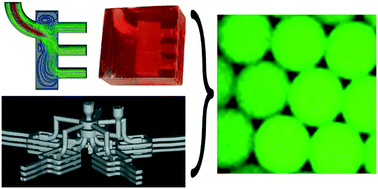Our official English website, www.x-mol.net, welcomes your feedback! (Note: you will need to create a separate account there.)
Engineering 3D parallelized microfluidic droplet generators with equal flow profiles by computational fluid dynamics and stereolithographic printing.
Lab on a Chip ( IF 6.1 ) Pub Date : 2019-12-16 , DOI: 10.1039/c9lc00980a Tom Kamperman 1 , Liliana Moreira Teixeira 2 , Seyedeh Sarah Salehi 3 , Greet Kerckhofs 4 , Yann Guyot 5 , Mike Geven 6 , Liesbet Geris 5 , Dirk Grijpma 6 , Sebastien Blanquer 7 , Jeroen Leijten 1
Lab on a Chip ( IF 6.1 ) Pub Date : 2019-12-16 , DOI: 10.1039/c9lc00980a Tom Kamperman 1 , Liliana Moreira Teixeira 2 , Seyedeh Sarah Salehi 3 , Greet Kerckhofs 4 , Yann Guyot 5 , Mike Geven 6 , Liesbet Geris 5 , Dirk Grijpma 6 , Sebastien Blanquer 7 , Jeroen Leijten 1
Affiliation

|
Microfluidic droplet generators excel in generating monodisperse micrometer-sized droplets and particles. However, the low throughput of conventional droplet generators hinders their clinical and industrial translation. Current approaches to parallelize microdevices are challenged by the two-dimensional nature of the standard fabrication methods. Here, we report the facile production of three-dimensionally (3D) parallelized microfluidic droplet generators consisting of stacked and radially multiplexed channel designs. Computational fluid dynamics simulations form the design basis for a microflow distributor that ensures similar flow rates through all droplet generators. Stereolithography is the selected technique to fabricate microdevices, which enables the manufacturing of hollow channels with dimensions as small as 50 μm. The microdevices could be operated up to 4 bars without structural damage, including deformation of channels, or leakage of the on-chip printed Luer-Lok type connectors. The printed microdevices readily enable the production of water-in-oil emulsions, as well as polymer containing droplets that act as templates for both solid and core-shell hydrogel microparticles. The cytocompatibility of the 3D printed device is demonstrated by encapsulating mesenchymal stem cells in hydrogel microcapsules, which results in the controllable formation of stem cell spheroids that remain viable and metabolically active for at least 21 days. Thus, the unique features of stereolithography fabricated microfluidic devices allow for the parallelization of droplet generators in a simple yet effective manner by enabling the realization of (complex) 3D designs.
中文翻译:

通过计算流体动力学和立体平版印刷技术,对具有相等流量分布的3D并行化微流体液滴生成器进行工程设计。
微流体液滴产生器擅长产生单分散的微米级液滴和颗粒。然而,常规液滴发生器的低通量阻碍了它们的临床和工业转化。当前使微型器件并行化的方法受到标准制造方法的二维性质的挑战。在这里,我们报告了由堆叠和径向多路通道设计组成的三维(3D)并行化微流液滴发生器的简便生产。计算流体动力学模拟构成了微流分配器的设计基础,该微流分配器可确保通过所有液滴生成器的流速相似。立体光刻技术是制造微器件的首选技术,它可以制造尺寸小至50μm的中空通道。微型设备可以在不影响结构变形(包括通道变形或芯片上印刷的Luer-Lok型连接器泄漏)的情况下操作至4 bar。印刷的微型设备可轻松生产油包水型乳剂,以及含聚合物的液滴,这些液滴既可作为固体也可作为核壳水凝胶微粒的模板。通过将间充质干细胞封装在水凝胶微胶囊中,证明了3D打印设备的细胞相容性,这导致可控地形成干细胞球体,这些球体至少在21天内保持活力并具有代谢活性。因此,通过立体光刻制造的微流体装置的独特特征,通过实现(复杂的)3D设计,可以以简单而有效的方式并行化液滴生成器。
更新日期:2020-02-13
中文翻译:

通过计算流体动力学和立体平版印刷技术,对具有相等流量分布的3D并行化微流体液滴生成器进行工程设计。
微流体液滴产生器擅长产生单分散的微米级液滴和颗粒。然而,常规液滴发生器的低通量阻碍了它们的临床和工业转化。当前使微型器件并行化的方法受到标准制造方法的二维性质的挑战。在这里,我们报告了由堆叠和径向多路通道设计组成的三维(3D)并行化微流液滴发生器的简便生产。计算流体动力学模拟构成了微流分配器的设计基础,该微流分配器可确保通过所有液滴生成器的流速相似。立体光刻技术是制造微器件的首选技术,它可以制造尺寸小至50μm的中空通道。微型设备可以在不影响结构变形(包括通道变形或芯片上印刷的Luer-Lok型连接器泄漏)的情况下操作至4 bar。印刷的微型设备可轻松生产油包水型乳剂,以及含聚合物的液滴,这些液滴既可作为固体也可作为核壳水凝胶微粒的模板。通过将间充质干细胞封装在水凝胶微胶囊中,证明了3D打印设备的细胞相容性,这导致可控地形成干细胞球体,这些球体至少在21天内保持活力并具有代谢活性。因此,通过立体光刻制造的微流体装置的独特特征,通过实现(复杂的)3D设计,可以以简单而有效的方式并行化液滴生成器。



























 京公网安备 11010802027423号
京公网安备 11010802027423号